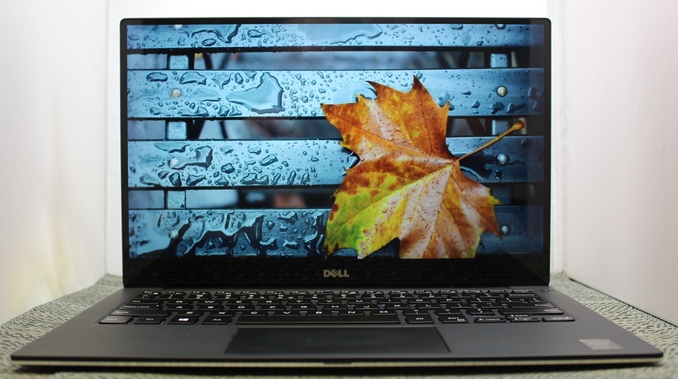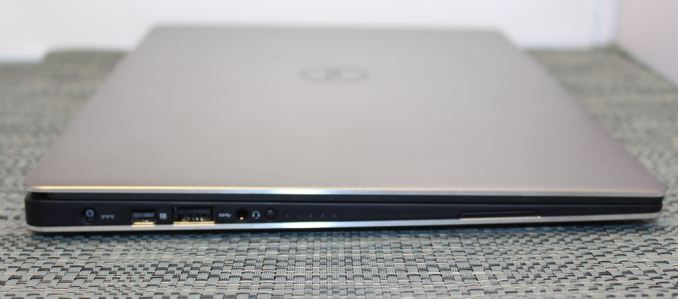Dell XPS 13 Review
by Brett Howse on February 19, 2015 9:00 AM EST- Posted in
- Laptops
- Dell
- Ultrabook
- Broadwell-U
- XPS 13

Dell launched the 2015 version of their XPS 13 at CES in January, and it made a big impression because of something that was very small. The first thing you see when you look at the XPS 13 is how small the bezels are around the display. At 5.2 mm, they are easily the thinnest display bezels on any laptop made today. Dell claims the XPS 13 is a 13 inch display in the chassis of an 11 inch notebook, and while they have made that claim before, for 2015, it would be hard to argue with them. But the XPS 13 is more than just a display, and Dell has outfitted it with some very modern hardware to give us our first look at an Ultrabook based on the just launched Intel 5th Generation processors, Broadwell-U.
At CES, Dell also told me that the new XPS 13 would have great battery life, with the company claiming that it would get up to fifteen hours. That claim seems hard to believe, with our battery life test topped at just a hair under ten hours by the current leader, the MacBook Air 13. However, this will be our first look at a laptop running on the new 14 nm process from Intel, so we can get a chance to see just how power efficient the new processors are.
Dell is offering quite an arrangement of options as well, allowing the new XPS 13 to fit into a lot more budgets than some of the other premium notebooks around. The base model comes with the Intel Core i3-5010U processor, but if you need more speed you can upgrade to the i5-5200U or i7-5500U. All of the storage options are solid state drives, which is great to see. The base is 128GB, and optional upgrades are to 256GB or 512GB. Memory choices are dual-channel 4GB DDR3L-RS-1600, or a dual-channel 8GB option.
We received two models for testing, with the first being a Core i5-5200U with the 1920x1080 non-touch display, 4GB of memory, and a 128GB SSD, which lists for $900. The second model is the Core i5-5200U, with 2x4GB of memory, a 256GB SSD, and the 3200x1800 touch display. This model lists at $1400.
Update: Originally I had listed the 4 GB model as single channel, but it is actually 2 x 2 GB for dual channel. Sorry for the mistake.
| Dell XPS 13 9343 Specifications | |
| Processor | Intel Core i3-5010U (Dual-core + HT 2.1GHz 3MB L3 14nm 15W TDP) Intel Core i5-5200U - model tested (Dual-core + HT 2.2-2.7GHz 3MB L3 14nm 15W TDP) Intel Core i7-5500U (Dual-core + HT 2.4-3.0GHz, 4MB L3, 14nm, 15W TDP) |
| Chipset | Broadwell-ULT |
| Memory | 2 x 2GB or 2 x 4GB DDR3L-RS-1600 (Dual Channel 8GB Max) |
| Graphics | Intel HD 5500 (23 EUs at 300-900MHz on Core i3) (24 EUs at 300-900MHz on Core i5) (24 EUs at 300-950MHz on Core i7) |
| Display | 13.3" Anti-Glare IPS 16:9 FHD (1920x1080) (Sharp 1420 Panel) 13.3" Glossy IPS 16:9 QHD+ (3200x1800) IGZO2 (Sharp 1421 Panel with Corning Gorilla Glass NBT and Touchscreen) |
| Storage | 128GB/256GB/512GB SSD (Samsung PM851 M.2 2280) |
| Optical Drive | N/A |
| Networking | Dell Wireless 1560 plus Bluetooth 4.0 - model tested (2x2:2 802.11ac 867Mbps capable Broadcom) Intel Dual Band Wireless-AC 7265 plus Bluetooth 4.0 (2x2:2 802.11ac 867Mbps capable) Intel Dual Band Wireless-N 7265 plus Bluetooth 4.0 (2x2:2 802.11n 300Mbps capable) |
| Audio | Realtek HD Stereo Speakers professionally tuned with Waves MaxxAudio Pro 1w x 2 Headset jack |
| Battery/Power | 52Wh non-removable 45W Max AC Adapter |
| Front Side | Charge Light |
| Left Side | Headset Jack Battery Meter 1 x USB 3.0 with PowerShare 1 x mini DisplayPort Speaker AC Power Connection |
| Right Side | Noble Lock Slot 1 x USB 3.0 with PowerShare SD Card Slot Speaker |
| Back Side | N/A |
| Operating System | Windows 8.1 64-bit |
| Dimensions | 11.98" x 7.88" x 0.33-0.6" (WxDxH) (304mm x 200mm x 9-15mm) |
| Weight | 2.6 lbs (1.18kg) Non-Touch 2.8 lbs (1.27kg) Touch |
| Extras | 720p HD Webcam Backlit Keyboard |
| Colors | Silver |
| Pricing | $800 (i3, 4GB, 128GB, FHD) $900 (i5, 4GB, 128GB, FHD) - model tested $1000 (i5, 8GB, 128GB, FHD) $1300 (i5, 8GB 128GB, QHD+) $1400 (i5, 8GB, 256GB, QHD+) - model tested $1600 (i7, 8GB, 256GB, QHD+) $1900 (i7, 8GB, 512GB, QHD+) |
The display has some choices as well. The base model comes with a 13.3 inch 1920x1080 IPS display, with a matte finish, and no touch capabilities. This is still a respectable 165 pixels per inch, and is a good option to keep the costs down. The upgraded display is quite the upgrade. Dell has worked with Sharp to outfit the XPS 13 with an optional 3200x1800 resolution IGZO panel, which features Corning Gorilla Glass NBT over the top, along with ten-point multitouch. This works out to 272 pixels per inch, and the IGZO panel is a full RGB stripe.
There are a couple of other options as well, such as a range of wireless adapters, with the Dell 1560 outfitted on the review laptops that we received. This is a Broadcom wireless adapter, with 802.11ac support. Some of the options, like the 512GB drive, are only available with the top CPU and upgraded display. Dell does offer some degree of flexibility when ordering, but not all options are available for all devices.
Dell has crafted a fine looking laptop, with some new parts from Intel and Sharp paving the way. On paper this is a great start, so let's get into the finer details.











201 Comments
View All Comments
qasdfdsaq - Friday, February 20, 2015 - link
Apple charge £120 to upgrade from a 1TB drive to a 3TB drive in an iMac 27". These are standard 3.5" desktop drives. The price difference between a 1TB drive and 3TB drive at retail is about £35. £120 may not sound like much but that's still 350% more than free market prices.Then there's the £800 for a 1TB SSD. Market prices are around £350. It's rather irrelevant if you can find a Samsung XP951 cheaper, they do not at any point advertise it being a Samsung XP951.
Even so, a 512GB XP951 costs £340 at retail, whereas the 'Apple cost' for it is around £450. And this is in a 27" iMac that can easily fit two, if not four 2.5" SSDs which would offer comparable storage and performance at less than half the cost - but they don't offer the option. Deliberately offering a very expensive option with no real advantages is the pretty much the definition of price gouging (note that I'm not referring to the US legal definition here)
Synomenon - Thursday, February 19, 2015 - link
So what's gaming performance like b/w the QHD+ and FHD versions if BOTH have 8GB of RAM?Jon Tseng - Thursday, February 19, 2015 - link
Interesting - all credit for testing QHD vs. FHD. I'd seen the other reviews (QHD only) showing mediocre battery life and had been wondering why 14nm was't delivering an improvement!odedia - Thursday, February 19, 2015 - link
I can't believe you published this but still didn't publish the iMac 5k review. Disappointing.Ryan Smith - Thursday, February 19, 2015 - link
To be clear, Brett's job here is to look at laptops and WinPhone devices. The iMac is my task, and what Brett works on has no impact on that.Samus - Thursday, February 19, 2015 - link
Dell's still trying to shake off their poor reputation during the 00's, especially with bomb's like the Inspiron 700mBut this is a solid machine.
piroroadkill - Thursday, February 19, 2015 - link
The Inspirons may have been shite back then, but I recall fondly the Latitudes and Precisions of those days. Chunky beasts, yes, but it was a period when you could get high res screens in a decent chassis. 1400×1050 14", 1920×1200 15", 1600×1200 15".. blah, blah.. Got a D800 that still works fine, with Radeon 9600 GPU. Hot shit for the time.bznotins - Thursday, February 19, 2015 - link
Wow, looks like a really nice laptop. I've always wondered why bezels had to be so large.I'm typing this on a 13" 2013 Retina MBP. Now that Windows is starting to get high dpi scaling into better shape, and vendors like Dell are making nice high-dpi hardware, I might be able to finally come back to the PC world. OSX just isn't that great, and running Windows on a mac isn't that great either.
Steveymoo - Thursday, February 19, 2015 - link
Looks like the laptop to beat for travelling photographers!John_dune - Thursday, February 19, 2015 - link
Brett, there is one question this review has left me, and it seems like a fairly big one... is there any aftermarket upgradability with this device? I currently have an Acer TimelineX 3810 that's almost hitting the end of its life, and i find that i don't really use the dedicated graphics for anything, and I was thinking about upgrading to this laptop. Would i be able for example to upgrade the ram myself to 8gb? or be able to put in a 512gb ssd (i'm assuming it's not a 2.5 inch hdd in there)?